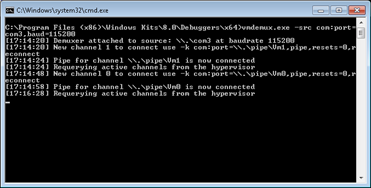
- #HYPER V 2012 COM PORT NAMED PIPE INSTALL#
- #HYPER V 2012 COM PORT NAMED PIPE SERIAL#
- #HYPER V 2012 COM PORT NAMED PIPE DRIVER#
- #HYPER V 2012 COM PORT NAMED PIPE DOWNLOAD#
- #HYPER V 2012 COM PORT NAMED PIPE WINDOWS#
#HYPER V 2012 COM PORT NAMED PIPE INSTALL#
This can be accomplished from the com0com command line setup: install EmuBR=yes EmuBR=yes The com0com installer wants to create a null modem pair from “cnca0” to “cncb0.” You’ll need this pair of virtual devices, and you’ll want to turn on “baud rate emulation,” and rename one end like a regular COM port.
#HYPER V 2012 COM PORT NAMED PIPE WINDOWS#
Since my guest is 32-bit Windows XP, I could use the precompiled “i386” binaries directly from the c0m0com sourceforge page. The guest is only slightly trickier, requiring both com0com and hub2com binaries to be installed. When done this way, the port is made available whether or not anybody is actually logged into the machine. It doesn’t matter what the Name of the String Value is, but the Data should be the command line necessary to launch the script: %WinDir%\system32\wscript "C:\Program Files (x86)\com0com\com3-listen.vbs" That’s best accomplished using the registry to create a new “Expandable String Value” under “HKEY_LOCAL_MACHINE\SOFTWARE\Microsoft\Windows\CurrentVersion\Run”. This script effectively hides the program so that it can run in the background, so all that remains is to have it launch when the system starts. ObjShell.Run "cmd /K CD C:\Program Files (x86)\com0com & com2tcp-rfc2217 COM3 7000", 0, false The simplest solution is to create a launcher script: Set objShell = CreateObject ("WScript.Shell") This gives me a DOS Window that shows me what’s going on - this is handy for debugging, but hardly something I want to leave on my screen all the time. My device is on COM3, and I can make it available on port 7000 using the following command line: com2tcp-rfc2217 COM3 7000
#HYPER V 2012 COM PORT NAMED PIPE DOWNLOAD#
This can be kind of a pain, especially if you’re using Visual Studio Express, so you’re welcome to download my 64-bit hub2com binaries here. Naturally, I’m running 64-bit Windows 2008, and there doesn’t appear to be a version compiled for 64-bit Windows, so I had to compile my own. The idea is to make a COM port on the host available via TCP/IP, and then attach to it via the guest, then make this process automatic.įirst, on the guest, you’ll need an appropriate version of hub4com, and the batch file bundled with it, com2tcp-rfc2217.bat. What follows is a recipe to access the physical COM ports on the host from a guest using com0com, and its related utilities. “Note: No access to a physical COM port is available from a virtual machine.” The Hyper-V Deployment guide contains little more than this:
#HYPER V 2012 COM PORT NAMED PIPE SERIAL#
(It appears that this option is used primarily for debugging programs, rather than for using actual serial ports - it doesn’t appear to have been intended to be used to provide actual serial port access from the guest.) Perversely, there are settings to connect the guest COM ports to “named pipes,” but there’s no way on the host to connect COM ports to named pipes. Notice how PowerShell shows two available COM ports? However, if you open the guest machine’s Device Manager, there won’t be any COM ports listed for the VM.Ĭheck out the example below (using COM1) to configure a pipe path for COM ports while a virtual machine is running:Īs mentioned before, when checking the guest machine’s Device Manager, COM1 isn’t displayed-but once the VM is shut down and restarted, the desired COM port will now be available from the list (see below.)įor those experienced with kernal debugging, the remaining process is fairly simple and straight-forward-with just one minor exception specific to Gen-2 VMs (even more specifically UEFI-based computers using Secure Boot.Unlike many other virtualization solutions, it’s not particularly easy to connect a Windows 2008 Hyper-V guest to its host serial ports. The reason being that, regardless whether serial ports are available or not, Gen-2 Hyper-V Manager never displays COM ports.īelow we’ll take a peak inside what PowerShell has to say:


In the below example, you’ll see that settings for a basic gen-2 virtual machine lacks COM port options.

#HYPER V 2012 COM PORT NAMED PIPE DRIVER#
The screenshots below are from a Windows 8 VM (specifically utilizing media created in the previous section where the driver for the software-based keyboard was added.) But there aren’t COM ports for Gen 2 VMs, right…?įrankly, the answer is a mix of yes and no (with the “no” mainly centered on default Hyper-V serial port passthrough capabilities.) The exciting news is, this is adjustable!


 0 kommentar(er)
0 kommentar(er)
